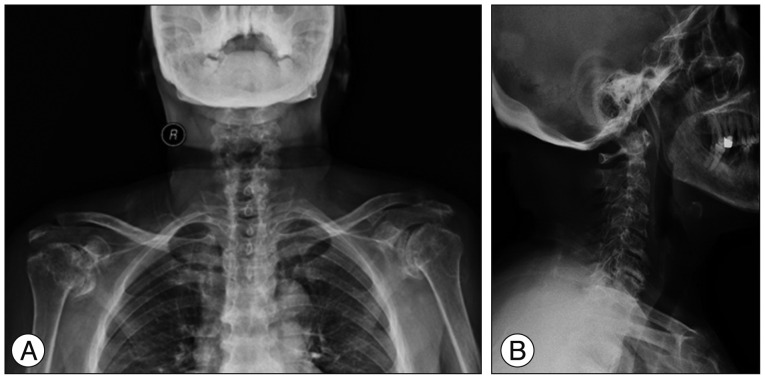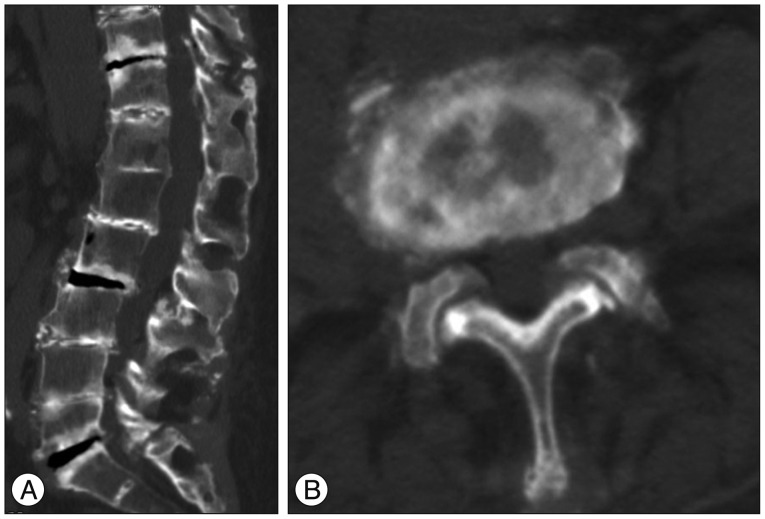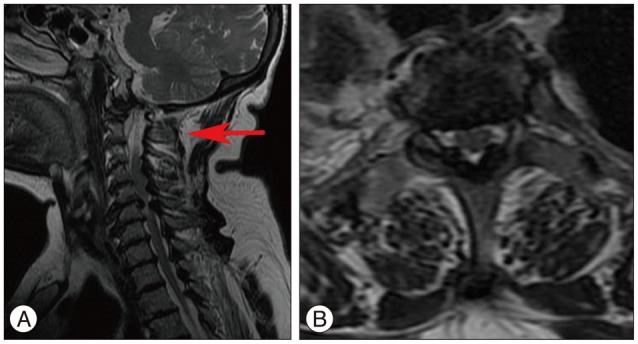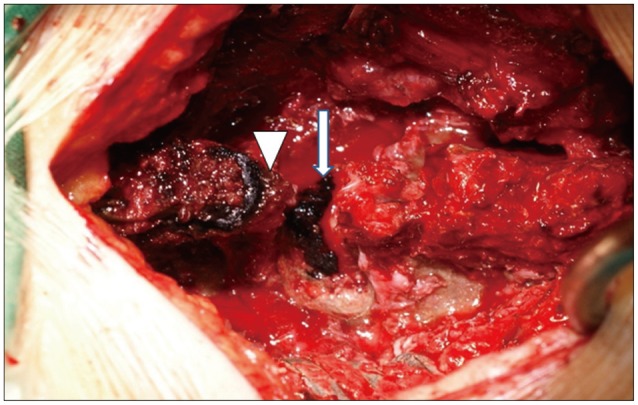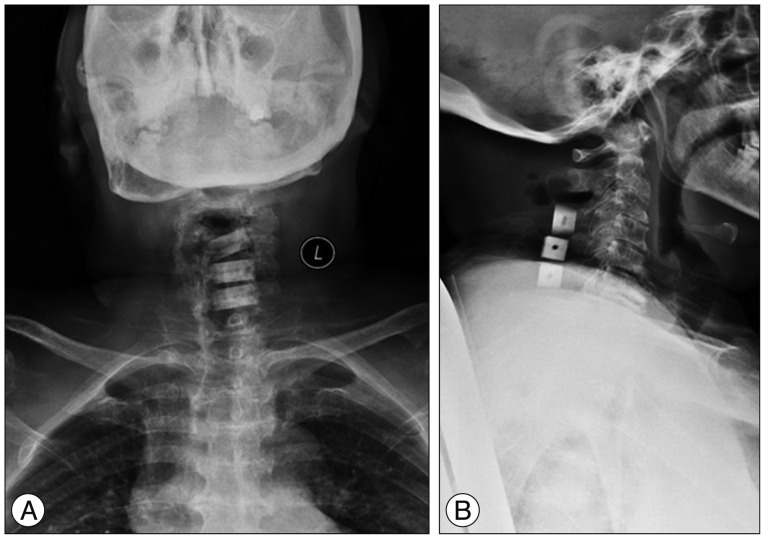J Korean Neurosurg Soc.
2016 Jan;59(1):65-68. 10.3340/jkns.2016.59.1.65.
Cervical Spondylotic Myelopathy due to the Ochronotic Arthropathy of the Cervical Spine
- Affiliations
-
- 1Department of Spine Surgery, Beijing Jishuitan Hospital, Beijing, China. spinejst@126.com
- KMID: 2152921
- DOI: http://doi.org/10.3340/jkns.2016.59.1.65
Abstract
- Ochronosis is a musculoskeletal manifestation of alkaptonuria, a rare hereditary metabolic disorder occurs due to the absence of homogentisic acid oxidase and leading to various systemic abnormalities related to deposition of homogentisic acid pigmentation (ochronotic pigmentation). The present case reports the clinical features, radiographic findings, treatments and results of a cervical spondylotic myelopathy woman patient due to the ochronotic arthropathy of the cervical spine. The patient aged 62 years was presented with gait disturbance and hand clumsiness. Physical examination, X-rays, computed tomography and lab results of the urine sample confirmed the presence of ochronosis with the involvement of the cervical spine. The patient underwent a modified cervical laminoplasty due to multi-segment spinal cord compression. The postoperative follow-up showed a good functional outcome with patient satisfaction. The present study concludes the conditions and important diagnostic and surgical aspects of a patient. It is necessary to identify the condition clinically and if cord compression is observed, appropriate surgical interventions needs to be instituted.
Keyword
MeSH Terms
Figure
Reference
-
1. Alrehaily A, Pope JE. Alkaptonuria with atypical joint involvement. J Rheumatol. 2002; 29:198–199. PMID: 11833486.2. Aynaci O, Onder C, Turhan AU. Bilateral hip arthroplasty for ochronotic arthropathy. Clin Rheumatol. 2000; 19:150–152. PMID: 10791629.
Article3. Chua SY, Chang HC. Bilateral spontaneous rupture of the quadriceps tendon as an initial presentation of alkaptonuria--a case report. Knee. 2006; 13:408–410. PMID: 16901704.
Article4. Corrà T, Zaccala M, Galante M. Ochronotic arthropathy : rapid destructive hip osteoarthritis associated with metabolic disease. Clin Rheumatol. 1995; 14:474–477. PMID: 7586989.
Article5. Dom K, Pittevils T. Ochronotic arthropathy : the black hip. Case report and review of the literature. Acta Orthop Belg. 1997; 63:122–125. PMID: 9265798.6. Emel E, Karagöz F, Aydín IH, Hacísalihoğlu S, Seyithanoğlu MH. Alkaptonuria with lumbar disc herniation : a report of two cases. Spine (Phila Pa 1976). 2000; 25:2141–2144. PMID: 10954648.7. Fernández-Cañón JM, Granadino B, Beltrán-Valero de Bernabé D, Renedo M, Fernández-Ruiz E, Peñalva MA, et al. The molecular basis of alkaptonuria. Nat Genet. 1996; 14:19–24. PMID: 8782815.
Article8. Gaines JJ Jr. The pathology of alkaptonuric ochronosis. Hum Pathol. 1989; 20:40–46. PMID: 2643557.
Article9. Justesen P, Anderson PE Jr. Radiologic manifestations in alcaptonuria. Skeletal Radiol. 1984; 11:204–208. PMID: 6719145.
Article10. Kusakabe N, Tsuzuki N, Sonada M. Compression of the cervical cord due to alcaptonuric arthropathy of the atlanto-axial joint. A case report. J Bone Joint Surg Am. 1995; 77:274–277. PMID: 7844136.
Article11. Van Offel JF, De Clerck LS, Francx LM, De Jonge MJ, Stevens WJ. A patient with ochronotic arthropathy and spondylopathy : a difficult differential diagnosis with spondylitis ankylosans. Clin Exp Rheumatol. 1995; 13:259–261. PMID: 7656475.12. Van Offel JF, De Clerck LS, Francx LM, Stevens WJ. The clinical manifestations of ochronosis : a review. Acta Clin Belg. 1995; 50:358–362. PMID: 8571731.13. Wolff JA, Barshop B, Nyhan WL, Leslie J, Seegmiller JE, Gruber H, et al. Effects of ascorbic acid in alkaptonuria : alterations in benzoquinone acetic acid and an ontogenic effect in infancy. Pediatr Res. 1989; 26:140–144. PMID: 2771520.
Article14. Zhao BH, Chen BC, Shao de C, Zhang Q. Osteoarthritis? Ochronotic arthritis! A case study and review of the literature. Knee Surg Sports Traumatol Arthrosc. 2009; 17:778–781. PMID: 19381613.
- Full Text Links
- Actions
-
Cited
- CITED
-
- Close
- Share
- Similar articles
-
- Retraction: Sensitivity of Pyramidal Signs in Patients with Cervical Spondylotic Myelopathy
- Value of Surgery and Nonsurgical Approaches for Cervical Spondylotic Myelopathy: WFNS Spine Committee Recommendations
- Delayed Bilateral C5 Palsy following Circumferential Decompression and Fusion in Patient with Cervical Spondylotic Myelopathy
- Hypertrophic Posterior Arch of Atlas Causing Cervical Myelopathy
- Sensitivity of Pyramidal Signs in Patients with Cervical Spondylotic Myelopathy


